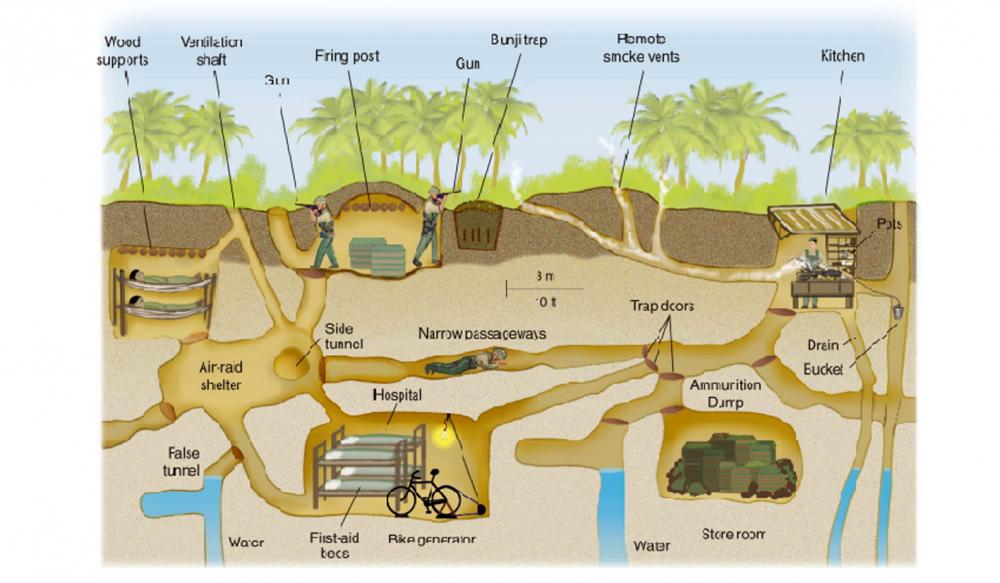
Di chuyển 70km về hướng Tây Bắc từ trung tâm Thành phố Hồ Chí Minh, khu di tích lịch sử Địa đạo Củ Chi là chứng nhân lịch sử cho sự biến hóa, sáng tạo của quân và dân Củ Chi trong cuộc kháng chiến ác liệt kéo dài suốt 30 năm chiến đấu chống lại kẻ thù xâm lược, góp phần quan trọng vào chiến thắng độc lập, tự do cho Tổ quốc.
Địa đạo Củ Chi đã đi vào lịch sử đấu tranh anh hùng của nhân dân Việt Nam như một huyền thoại của thế kỷ 20. Với sức mạnh và ý chí quật cường, quân và dân Củ Chi đã kiến tạo được một hệ thống đường hầm dọc ngang, nhiều tầng, với khoảng 250km xuyên trong lòng đất, cùng các công trình liên hoàn như chiến hào, công sự trên mặt đất, tựa như “thiên la địa võng”, khiến kẻ thù phải khiếp sợ.
Trong hầm có nơi làm việc của lãnh đạo, nơi dự trữ vũ khí, lương thực, thực phẩm, có giếng nước, bếp “Hoàng Cầm”, hầm giải phẫu, nuôi dưỡng thương binh, hầm chữ A vững chắc cho phụ nữ, người già, trẻ em trú ẩn…
Hiện nay, khu di tích lịch sử Địa đạo Củ Chi là nơi giáo dục truyền thống cách mạng, chủ nghĩa yêu nước, thể hiện đạo lý “uống nước nhớ nguồn”, tri ân công ơn to lớn của các anh hùng, liệt sĩ, đã chiến đấu, hy sinh trên vùng đất Sài Gòn – Chợ Lớn – Gia Định trong hai cuộc chiến tranh giải phóng dân tộc.
Đến đây, du khách sẽ cảm nhận được không khí lịch sử, hình dung thêm những khó khăn, vất vả mà quân và dân ta từng trải qua trong chiến tranh. Từ đó càng khơi dậy niềm tự hào về khả năng sáng tạo kiệt xuất và tinh thần bất khuất, đoàn kết của nhân dân Việt Nam.
Located 70km northwest of the center of Ho Chi Minh City, the Cu Chi Tunnels Historical Site stands as a testament to the historical transformations and innovations of Vietnamese people and military in Cu Chi during the 30-year intense war against invading enemies in pursuit of national independence and freedom.
The Cu Chi Tunnels have been inscribed into the annals of 20th-century Vietnam’s legend, symbolizing the resilience and determination of the Vietnamese people. They meticulously excavated an extensive network of approximately 250km of horizontal tunnels underground, complemented by surface structures such as trenches and bunkers. This system operated like a formidable “spider’s web”, striking fear into the hearts of the enemy.
The tunnels accommodated various amenities and facilities, including workplaces for leaders, storage areas for weapons, provisions, and food, along with wells, the “Hoang Cam” kitchen, a medical bunker, facilities for tending to wounded soldiers, and fortified shelters such as the A-shaped bunker where women, the elderly, and children sought refuge.
Today, the Cu Chi Tunnels Historical Site serves as an educational venue for revolutionary traditions, patriotism, and the principle of “remembering your roots”, as well as a place to express gratitude for the immense contributions of the heroes and martyrs who fought and sacrificed in the Saigon-Cholon-Gia Dinh region – one of the most important battlegrounds during the two wars of national liberation.
Amidst the historical atmosphere, visitors to this site will acquire a better understanding of the challenges and hardships faced by the Vietnamese military and people during the wars. This allows them to be able to understand how the exceptional creativity and indomitable spirit have helped the Vietnamese people win the wars.



